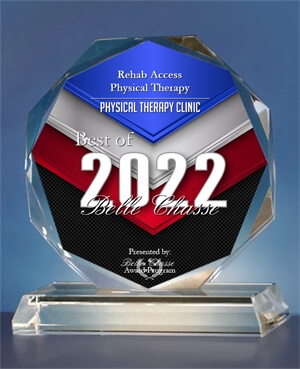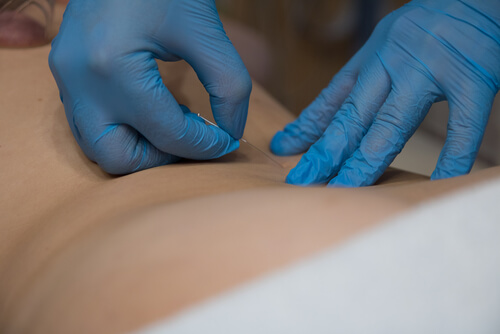When you think of physical therapy, many different things may come to mind. A physical therapist can guide you through targeted stretches, use their hands to loosen up tight muscles and even show you aquatic therapy exercises. Another common physical therapy treatment for pain management is dry needling.
Dry needling in physical therapy refers to the use of thin needles to reduce pain and increase mobility. By inserting the needles into the affected areas, particularly your trigger points, the muscles will contract, resulting in a release of tension. It may be confused with acupuncture, but dry needling is based in Western medicine to alleviate myofascial pain. Acupuncture uses the Chinese “chi” theory to realign the body’s energy for healing.
It’s also important to note that physical therapists must become certified to perform dry needling, making it a specialized treatment.
Why should you explore dry needling during your physical therapy sessions? That’s what we’re here to discuss. We’ll talk about the benefits you can gain from the technique as well as conditions that it may be used to help. We’ll also discuss what you can expect from dry needling sessions during physical therapy treatment.
6 benefits of dry needling during physical therapy
By talking with your physical therapist, you’ll explore the safest and most effective treatment options for your pain. One of the options may be dry needling. You’ll collaborate with your therapist to determine if dry needling will work for you based on your symptoms and medical history. While we’ve mentioned how it can help alleviate your pain, the benefits of this technique go beyond that.
There are many types of treatments that can reduce your pain and help you heal from a medical condition or injury. So what makes dry needling stand out from the rest? Here are six ways you can benefit from dry needling during physical therapy:
- Quick results — Every patient wants to have quick relief after finishing a physical therapy appointment. Each case is different; even so, dry needling patients tend to report pain relief and increased mobility almost immediately. While many people will require multiple sessions for long-term results, they often report significant improvement after just the first one. The increased blood circulation can speed up the recovery process.
- Minimal pain and side effects — It can be worrying when you don’t know how your body will react to a treatment. The good news is that most patients who undergo dry needling experience little to no pain during the treatment. While there’s a possibility of minor side effects, such as soreness or bruising, they are temporary. Your physical therapist can make adjustments for future sessions to ensure that it’s as painless as possible.
- Holistic approach — Many physical therapy treatments improve your health and wellness by helping you beyond your main concerns. That’s why many physical therapists prioritize a holistic approach to their treatments. Dry needling targets specific areas. It encourages natural healing throughout the whole body, which can benefit your overall well-being for an improved quality of life.
- Combined with other treatments — Your treatment plan should be as comprehensive as possible to address your condition from every angle. Dry needling can be incorporated into a treatment plan alongside other techniques to maximize your results and improve the overall quality of the affected area. Dry needling is often performed in tandem with manual therapy, guided exercises or aquatic therapy.
- Goes deeper than manual therapy — As we mentioned above, manual therapy is often utilized for many of the same conditions that dry needling is. Manual therapy involves the therapist using their hands to manipulate the affected soft tissue to release muscle tension and improve range of motion. Dry needling goes a bit deeper into the affected area than a therapist can accomplish with their hands alone. The needles directly stimulate the muscles, tendons and ligaments.
- Reduced reliance on medication — While medication can play an important role in pain management, depending on a nonsteroidal anti-inflammatory drug for an extended period of time can lead to side effects, such as nausea and heartburn. Dry needling is a natural treatment option that can help reduce pain and inflammation without ingesting synthetic medicine. The needle is “dry” because it doesn’t inject medication.
Who can benefit from dry needling during physical therapy?
Now you know that dry needling can help reduce your pain and improve your range of motion that may be affected by a condition or injury. But what type of patients can actually benefit from dry needling?
Dry needling can help with many musculoskeletal issues that can interfere with one’s ability to carry out everyday activities. It’s often used to alleviate muscle pain and stiffness, which can reduce mobility and function.
Your physical therapist may recommend dry needling if you’re experiencing:
- Neck and back pain.
- Headaches.
- Hip and knee pain.
- Tendinitis.
- Whiplash.
- Temporomandibular joint disorders, or TMJ.
- Carpal tunnel syndrome.
- Plantar fasciitis.
What you should know before starting dry needling during physical therapy
Knowing what to expect from a treatment like dry needling can help alleviate your nerves so you can focus on continuing along your health and wellness journey. While the specifics can vary from patient to patient based on the location, cause and severity of their symptoms, here are a few things to keep in mind:
- Session length — On average, a dry needling session can take between 20 and 30 minutes, making it a flexible option for patients who have a packed schedule. The needles can stay in your body from 10 seconds up to 20 minutes.
- Medication — Talk to your physical therapist before the session about the option of taking an over-the-counter pain medication to encourage your muscles to loosen up. On the same note, be sure to let them know about any medications you are taking, including anticoagulants, which may result in bruising from the needles.
- Keeping moving — As we mentioned earlier, there’s a possibility that you’ll feel sore after a dry needling session. That’s why it’s important that your muscles stay loose afterward. Try to avoid staying sedentary for extended periods of time after you leave the clinic to reduce the risk of soreness.
Rehab Access can help you explore the option of dry needling during physical therapy
When you start physical therapy, it’s important that you collaborate with your therapist to make sure that you’re aware of every option available to you. While the use of the word “needle” can be intimidating to some people, dry needling is offered at many clinics because it gets patients the results that they’re looking for.
At Rehab Access, we have physical therapists who are certified in dry needling and will ensure that you have the most comfortable experience possible while reducing your pain and muscle tension. Our goal is to help you reduce your pain while improving the mobility of the affected area so that you can return to your everyday activities.
We’ll start off your first appointment with an initial evaluation. This can include a physical assessment of the affected area along with a discussion of your symptoms and medical history. A physical therapist will determine the likely cause of your pain and stiffness before determining if dry needling is the right option for you.
We offer dry needling at our Gretna and Belle Chasse, Louisiana, locations with physical therapists who are trained and certified to safely carry out the treatment.
Call us or request an appointment today if you believe that dry needling with physical therapy might be right for you.



